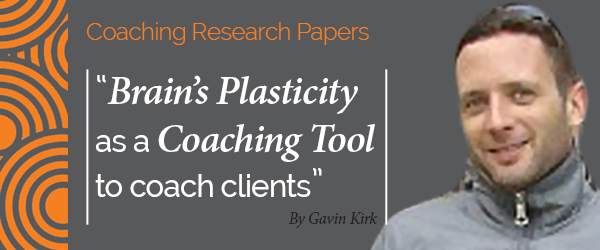 Research Paper By Gavin Kirk
Research Paper By Gavin Kirk
(Personal Transformation Coach, SOUTH AFRICA)
Using The Mind to Change The Brain to Change The Mind
What can discoveries made at the intersection of Positive Psychology, neurology, and mindfulness show coaches, and how can these discoveries be applied to coaching?
This research paper aims to answer those questions by linking the research findings of Martin Seligman (Positive Psychology/Well-Being Theory) and Rick Hanson (Self-Directed Neuroplasticity) with the meditation practices of the Buddha Having done that, this paper will examine how clients can be coached using the brain’s plasticity as a coaching tool.
What is Coaching?
People seek out coaching with a sense that something is not quite as it should be They need to get from where they are to where they would like to be. This felt need – this sense of dissatisfaction – is arguably the basis for almost all coaching in that it is the motivation for some kind of change. So coaching has something to do with change.
The International Coach Federation defines coaching as
partnering with clients in a thought provoking and creative process that inspires them to maximize their personal and professional potential.
It adds that
professional coaching …focuses on an individual’s life as it relates to goal setting, outcome creation and personal change management (International Coach Federation: 2012).
Or simply: coaches help clients increase their self-awareness so that they are better able to be self-decisive in their lives and subsequently, take self-directed action.
There are as many measures as there are coaches for determining the effectiveness of coaching. This paper uses Martin Seligman’s research and measures for happiness, and more broadly, well-being as a useful yardstick.
Seligman’s Well-Being Theory
According to Martin Seligman,
the goal of Positive Psychology is to increase flourishing by increasing positive emotion, engagement, positive relationships, purpose and meaning, and accomplishment (PERMA). PERMA can be used as both a subjective and an objective measurement of well-being.
Mindfulness Meditation
Another tool that has been used to increase well-being is meditation. It has received a lot of attention over the past few decades as a relatively easy way to improve physical, emotional, mental, and spiritual well-being. The many benefits of meditation have long been known to practitioners, and more recently, Western science.
Meditation has been shown to help with insomnia, anxiety, phobias, chronic pain,type II diabetes, asthma, and cardiovascular disease, among others. Research findings show that meditation decreases stress-related cortisol and strengthens the immune system. In addition to these positive results, meditation also has a structural effect on the physical brain.
What’s Happening in the Brain?
Meditation has been shown to result in physical changes to the brain. Regular meditation
Explicit Vs Implicit Memory
Much as your body is built from the foods you eat, your mind is built from the experiences you have. The flow of experience gradually sculpts your brain, thus shaping your mind. Some of the results can be explicitly recalled: This is what I did last summer; that is how I felt when I was in love. But most of the shaping of your mind remains forever unconscious. This is called implicit memory, and it includes your expectations, models of relationships, emotional tendencies, and general outlook. Implicit memory establishes the interior landscape of your mind what it feels like to be you – based on the slowly accumulating residues of lived experiences (Hanson: 67).
Implicit memory is affected by the feeling tone of the experience. Put another way, when we have an experience, the facts get stored as explicit memory, while the feeling, positive or negative, gets stored as implicit memory. The implicit memories become the ‘residues of lived experiences.’ The feeling tone of each of these residues below our awareness is largely shaped by whatever was in our awareness while the experiences were being consolidated.
If implicit memory establishes the interior landscape of your mind, it is clearly an important contributor to well being.
Mindful Attention
Buddhism teaches that the mind takes the shape of whatever it rests upon – or more exactly, the brain takes the shape of whatever the mind rests upon. So, if you regularly rest your mind on regrets, resentments, quarrels with others, self- reproach – you know, the voice in the back of the head yammering away about-what a nobody you really are and if others only knew better, etc – if you rest your mind there, it will change your brain in that direction, because neurons that fire together wire together, for better or worse. On the other hand, if you rest your mind on wholesome themes, those things that are going well, what you’re grateful for, good connections you have with others, your good qualities, what you accomplish in a day, the conditions in the world that are okay, you’re going to build up neural substrates and circuits of positivity (Noetic Now Journal: 2011).
This process of resting one’s mind on wholesome themes is what Hanson calls ‘Taking in the Good.’
PERMA and Plasticity
Combining Seligman’s measure of well-being, and Hanson’s ‘Taking in the Good’, coaches have a powerful tool to use with their clients.
‘Taking in the Good’ can be used in whatever way seems appropriate for the client That might be as a formal meditation practice or more informally as they see fit. Whichever is chosen, the process begins in the same way.
Turn Positive Facts into Positive Experiences
The first step in ‘Taking in the Good’ is to begin noticing positive facts; to become aware of what’s good and then embody them as positive experiences.
Coaches can work with their clients and help them identify positive emotions, and relationships. Coaches can help clients remember times when they’ve been inflow, when they’ve been engaged, as well as all the things they’ve accomplished in their lives. The same can be done for a sense of purpose and meaning.